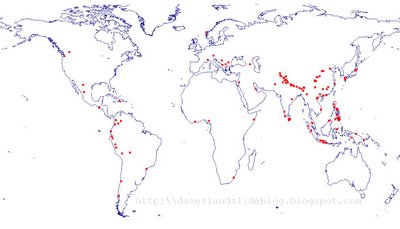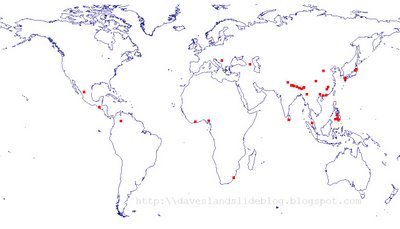2 July 2008
June 2008 fatal landslide map
Posted by Dave Petley
The map below shows the distribution of fatal landslides for June 2008. The statistics are:
Number of fatal landslides: 43
Number of fatalities: 215
As has been the pattern all year, June was substantially below the average number of fatalities for may in 2003-2007, which is 334 deaths. Interestingly, during June there have been extensive reports of intense and prolonged rainfall events, but this does not seem to have translated into fatal landslides. The reasons for this are unclear to me.
The patterns that were starting to emerge in the annual map over the last few months are now clear. In particular the clusters in the Himalayas, western Central America, the Philippines and Indonesia are now very obvious. Whereas last month the cluster in the Himalayas was focused on the western part of the mountain chain, it has now extended to the east as the monsoon rainfall has intensified. The pattern of more landslides in Central America than is normal is continuing. China is continuing to get a fair number of fatal landslides. It is also interesting to see the occurrence of several landslides in SE. Europe.
 Recorded fatal landslides in 2008 up to the end of June. Each dot represents a single landslide. Click on the map for a larger version in a new window.
Recorded fatal landslides in 2008 up to the end of June. Each dot represents a single landslide. Click on the map for a larger version in a new window.


 Dave Petley is the Vice-Chancellor of the University of Hull in the United Kingdom. His blog provides commentary and analysis of landslide events occurring worldwide, including the landslides themselves, latest research, and conferences and meetings.
Dave Petley is the Vice-Chancellor of the University of Hull in the United Kingdom. His blog provides commentary and analysis of landslide events occurring worldwide, including the landslides themselves, latest research, and conferences and meetings.
Dear Sir,Considering the monsoon rainfall in India, the reason for a reduced rate of landslide and thus landslide related fatality is well explained at least for India. The rainfall up till today is 38% less than the long period average in Kerala according to the Indian Meteorology Department. Instead of having a low pressure belt along the Arabian sea, we are baffled by a high pressure system and the situation is expected to continue for at least 1 more week implying that rains and thus landslides will be of a lesser number than in 2007 (49 landslides in 2007 in Kerala alone). What will be interesting is to watch out for the north east monsoon starting October. Given that the soil is still moist, if we experience high intensity rainfall in the north east monsoon season we may get larger and wide spread landslide activity in the Western Ghats. Situation may be different in Himalayas. This is just an opinion sir, I may be completely wrong.